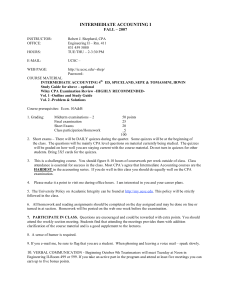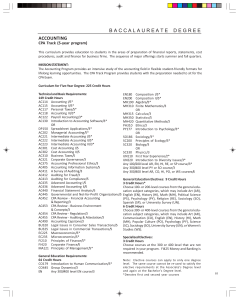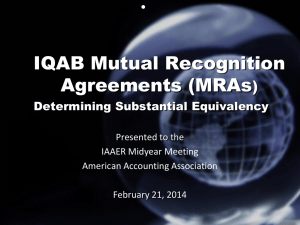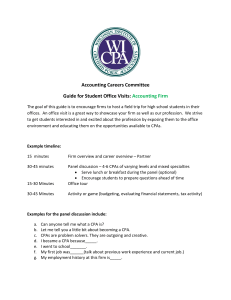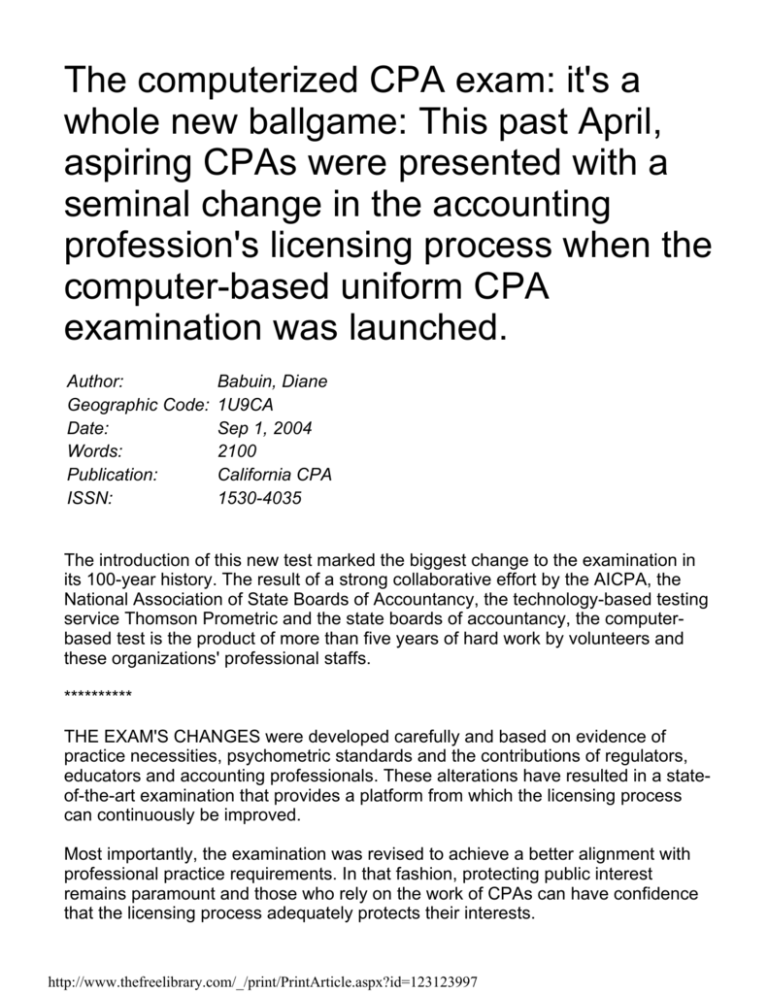
The computerized CPA exam: it's a
whole new ballgame: This past April,
aspiring CPAs were presented with a
seminal change in the accounting
profession's licensing process when the
computer-based uniform CPA
examination was launched.
Author:
Geographic Code:
Date:
Words:
Publication:
ISSN:
Babuin, Diane
1U9CA
Sep 1, 2004
2100
California CPA
1530-4035
The introduction of this new test marked the biggest change to the examination in
its 100-year history. The result of a strong collaborative effort by the AICPA, the
National Association of State Boards of Accountancy, the technology-based testing
service Thomson Prometric and the state boards of accountancy, the computerbased test is the product of more than five years of hard work by volunteers and
these organizations' professional staffs.
**********
THE EXAM'S CHANGES were developed carefully and based on evidence of
practice necessities, psychometric standards and the contributions of regulators,
educators and accounting professionals. These alterations have resulted in a stateof-the-art examination that provides a platform from which the licensing process
can continuously be improved.
Most importantly, the examination was revised to achieve a better alignment with
professional practice requirements. In that fashion, protecting public interest
remains paramount and those who rely on the work of CPAs can have confidence
that the licensing process adequately protects their interests.
http://www.thefreelibrary.com/_/print/PrintArticle.aspx?id=123123997
Now that the first testing window (April 5-May 29) has been completed, the
question that is on everyone's mind is, "How did it go?" The answer: Very well.
Compared to other known computer-based test conversion projects, the
CPA examination has gone remarkably well.
During April and May, some 23,000 test sections were delivered. Approximately 92
percent of the test takers reported that they'd had a positive testing experience. Of
course, there are issues and challenges to be addressed, but as a profession we
can take pride that the CPA examination continues to evolve in a positive manner
and meet its mission of protecting the public.
The state boards of accountancy, with responsibility for the entire CPA licensing
process, appear to be increasingly comfortable with the computer-based test
process. While communication and some functionality and administrative
operations need to be fine-tuned, the exam and the work that has been
accomplished thus far is impressive.
But that doesn't mean the job is done. This initial testing window is just the first step
of an ongoing evolution that will foster continuous innovation and exceptional
quality. The CPA exam must keep pace with the business world and the work done
by CPAs. Also, it's important to ensure that the CPA examination remains the
premier financial licensing test and an effective tool for state boards of accountancy
to use in their licensing procedures.
A BETTER-ALIGNED EXAMINATION
While the test's most visible change is its transition from a paper and pencil exam
to a computer-based test, the more important components are the content
revisions. Based on practice analysis findings, the computer-based exam has been
revised to more closely align with an entry-level CPA's real-world, professional
responsibilities.
[ILLUSTRATION OMITTED]
Through amended content, format and delivery, plus a new case study component
called "simulations," the new exam strives to evaluate the research, analytical,
judgment and communication skills required of entry-level CPAs.
The result is a 14-hour test with four sections:
* Auditing and Attestation,
* Financial Accounting & Reporting,
http://www.thefreelibrary.com/_/print/PrintArticle.aspx?id=123123997
* Regulation, and
* Business Environment & Concepts.
The new sections' specifications were established independently of the paperbased test's specifications and the material differences between the structures are
summarized as follows:
The subject areas that were tested in the paper and pencil section Accounting &
Reporting--taxation, governmental and nonprofit organizations, and managerial-have been separated and grouped with subject matter that is more logically related.
Specifically, the topic of accounting and reporting for governmental and nonprofits
has been placed in Financial Accounting & Reporting; taxation has been placed in
Regulation; and managerial accounting has been placed in Business Environment
& Concepts.
Candidates are required to demonstrate general business knowledge that is related
to auditing and financial reporting primarily in the new section: Business
Environment & Concepts. In addition to managerial accounting, the Business
Environment & Concepts section tests candidates' knowledge of certain areas of
economics, finance, strategy and information technology.
For more information about the exam's content, the application or scheduling
process, as well as links to the state boards of accountancy, NASBA and
Prometric, visit the CPA exam website at www.cpa-exam.org.
FOCUS ON CONTENT, NOT PROCESS
Test administration also has been updated with expanded testing opportunities and
increased flexibility. Candidates now have more than two testing opportunities per
year and are no longer required to take all four sections at one time.
With the computer-based format, individuals deemed eligible by their state boards
of accountancy can schedule any or all sections in two out of three months each
quarter, throughout the year. These two-month periods are known as "testing
windows." Within broad constraints, candidates are able to choose the date, time
and test center most convenient for them and their employers.
Once a section is passed, most jurisdictions require candidates to pass all
remaining sections within 18 months to receive credit on the previously passed
section(s). As an "early bird" incentive, California offered a 24-month creditretention period to those candidates sitting for the first two testing windows (AprilSeptember 2004). But after September 2004, the credit-retention period becomes
18 months for every subsequent exam.
http://www.thefreelibrary.com/_/print/PrintArticle.aspx?id=123123997
Conceptually, it's important that competency in all areas that are considered
essential for the protection of the public interest be demonstrated within a
reasonable time frame.
Knowledge and abilities demonstrated at one point in time on a particular subject
can become stale and no longer useful as evidence of competency over time. The
period of 18 months represents the Board of Examiners' judgment as to the
reasonable period of time for such a show of competency.
COLLABORATIVE EFFORT
The strong, collaborative effort among the AICPA, NASBA, state boards of
accountancy, educators and the accounting profession is a key to maintaining the
computer-based exam's integrity and strength.
For example, before test items or simulations are included for scoring on an actual
exam, the AICPA conducts extensive pre-testing to ensure that individual questions
perform as expected and are at the appropriate level of difficulty.
This collaborative effort was instrumental to the process of determining the passing
standard for the new exam. In layman's terms, the passing standard sets the bar
that candidates must meet to demonstrate that they have the knowledge and skills
necessary for licensure.
Because the test is a high-stakes element of the licensure process, standardsetting that distinguishes between successful and unsuccessful candidates must
assure protection of the public interest and allow for defensible and fair pass/fail
decisions.
The development of a passing standard is founded in a standard-setting study and
other factors, including the professional judgment of the policy-setting body, in this
case, the AICPA Board of Examiners.
The standard-setting process was rigorous and included input from NASBA, state
board of accountancy members and several psychometric consultants.
As a result, the computerized CPA examination is an effective, state-of-the-art tool
for making licensing decisions.
Overall, the computer-based exam's launch was an historic event. Now we must
continue to learn from our experience and continue to make the CPA examination,
and the accounting profession, the best that they can be.
2004-05 Testing Windows
Testing Available
No Testing
http://www.thefreelibrary.com/_/print/PrintArticle.aspx?id=123123997
October-November 2004
January-February 2005
April-May 2005
July-August 2005
October-November 2005
December 2004
March 2005
June 2005
September 2005
December 2005
RELATED ARTICLE: Before You Take the CPA Exam
Now that the computerized CPA examination's first testing window is complete, the
experience has shown that there are some things CPA candidates need to know
before they take the exam. These tips also are available on the CPA exam website
www.cpa-exam.org or in the CPA Examination Candidate Bulletin.
Exam Functionality & Navigation
Be sure you are comfortable with the use of a computer keyboard and mouse, plus
common word processing and spreadsheet functions. However, the word
processing and spreadsheet applications in the examination are not identical to
Word or Excel. Review the exam tutorial to understand the differences.
Take the tutorial and sample test (several times, if necessary) before you take the
exam. The tutorial and sample tests are available at www.cpa-exam.org. Pay
special attention to the software features that are unique to this examination,
especially in the Authoritative Literature portion of the test. Be sure to read the
directions in this section very carefully:
* History button: Use this to find the last page visited (a Back button is not
available). By clicking on History, you will be able to obtain a list of up to 20 lastpage visits in reverse order.
* Copy/paste: In the Authoritative Literature portion, you can highlight or copy/paste
only a block of text (not separate lines or words) at a time.
* Only the Copy icon in the Authoritative Literature window will copy/paste
highlighted text. Do not use the icon in the main toolbar.
* In the tutorial, find specific copy and paste tips as follows:
* For Audit simulation instructions, refer to Review Letter Item Type:
* For FAR simulation instructions, refer to Accounting and Reporting Item Type;
* For REG simulation instructions, refer to Tax Citation Item Type.
http://www.thefreelibrary.com/_/print/PrintArticle.aspx?id=123123997
* Search: You will have to scroll down to view all topics returned by a search; if you
spell words incorrectly, you will not receive any search results.
* Calculator: You will be able to enter numbers on the online calculator using the
keyboard or the keypad with the NumLock feature turned on. Be sure you
understand how to move the calculator on the screen.
Remember that the examination consists of several sections (groups of multiple
choice questions called testlets or simulations). You will be able to review
questions within any testlet/simulation, but you will not be able to go back to a
testlet/simulation once you have exited from it.
Scheduling the Exam
When you receive your Notice to Schedule, check the accuracy of your name. The
same version of your name must appear on your application, the NTS and the
identification you present at the testing center. If your name on this document is not
correct, contact your state board of accountancy at least 10 days before your test
appointment.
Schedule through www.prometric.com/cpa. This website is available 24 hours a
day and also can be used to cancel or reschedule appointments.
Schedule early. It is recommended that you schedule 45 days in advance of your
preferred test date.
The appointment time (on the schedule confirmation) is 30 minutes longer than
your exam time to allow you to complete the sign-in process and survey. This time
is independent of your exam. Completing these activities quickly will not give you
extra time on the exam.
At the Test Center
Bring your Notice to Schedule to the testing center. You cannot test without it. Test
Center personnel are required to turn CPA candidates away if they do not have
paper copy of this document.
In addition to the NTS, every candidate must bring two valid forms of ID with them
to the Test Center. The spelling of the name on this ID must match the spelling on
the NTS exactly letter for letter. A CPA candidate will not be allowed to test if their
ID and NTS do not match. Please see the CPA Examination Candidate Bulletin for
a list of valid forms of primary and secondary identification.
Arrive at least 30 minutes early and be sure to have your Examination Password on
http://www.thefreelibrary.com/_/print/PrintArticle.aspx?id=123123997
hand (it's provided on your Notice to Schedule) when you are seated at the
workstation. You have a limited amount of time available to enter this information
once you are seated.
Be sure to follow research problem directions. If you are having difficulty entering a
response in the space provided, you may not be using the expected response
format.
Report any functionality problems to the Test Center Administrator. If possible, wait
until the end of the session. If you encounter a problem in a simulation, be sure to
identify the TAB in which it occurred.
Don't be distracted by any issue as long as you are able to continue testing. For
example, if your responses do not generate the expected result, be sure to read the
directions and continue testing. Report this matter to the TCA at the end of the
session so that a report can be filed. The system will verify the capture of your
responses.
Keep the Confirmation of Attendance form you receive after the exam. This not
only verifies that you took the exam, but also contains contact information about
reporting any concerns, complaints or questions about the exam.
BY WILLIAM W. HOLDER, CPA, AND DIANE BABUIN
William W. Holder, CPA, chair of the AICPA Board of Examiners, is the Ernst and
Young Professor of Accounting at the University of Southern California. He can be
reached at wholder@marshall.usc.edu. Diane Babuin is a communications
manager at the AICPA and can be reached at dbabuin@aicpa.org.
COPYRIGHT 2004 California Society of Certified Public Accountants
Copyright 2004, Gale Group. All rights reserved. Gale Group is a Thomson Corporation
Company.
http://www.thefreelibrary.com/_/print/PrintArticle.aspx?id=123123997

